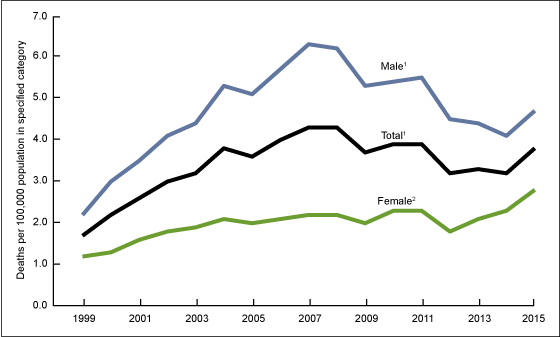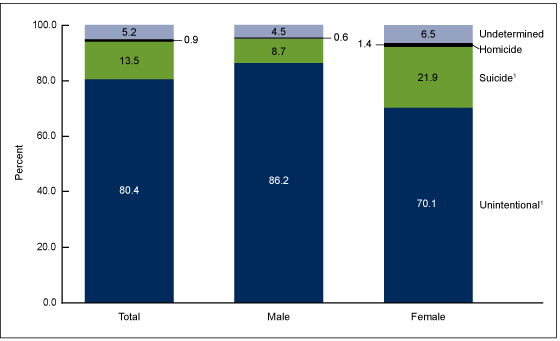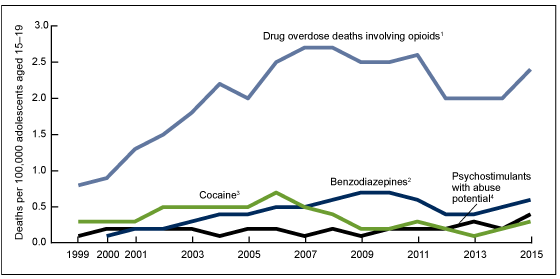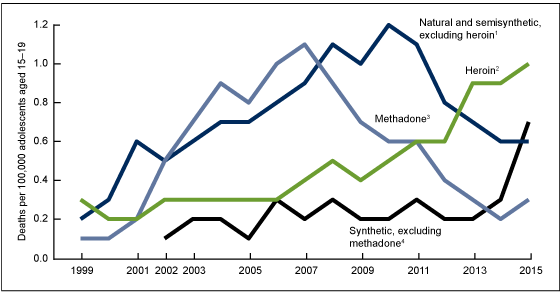Drug Overdose Deaths Among Adolescents Aged 15–19 in the United States: 1999–2015
- Key findings
- After increasing from 1999 through 2007, drug overdose death rates for adolescents aged 15–19 declined through 2014, but then increased in 2015.
- The majority of drug overdose deaths in 2015 for both males and females were unintentional.
- Rates of drug overdose deaths involving opioids among adolescents aged 15–19 tripled from 1999 to 2007, generally declined from 2007 to 2014, and then increased in 2015.
- Among opioids, rates of drug overdose deaths among adolescents aged 15–19 in 2015 were highest for heroin.
- Summary
- Data source and methods
- About the authors
- References
- Suggested citation
NCHS Data Brief No. 282, August 2017
PDF Versionpdf icon (383 KB)
Sally C. Curtin, M.A., Betzaida Tejada-Vera, M.S., and Margaret Warner, Ph.D.
Key findings
Data from the National Vital Statistics System
- The death rate due to drug overdose among adolescents aged 15–19 more than doubled from 1999 (1.6 per 100,000) to 2007 (4.2), declined by 26% from 2007 to 2014 (3.1), and then increased in 2015 (3.7).
- The drug overdose death rate increased between 1999 and the mid-2000s for both males and females but only males had a subsequent decline between 2007 and 2014.
- For both male and female adolescents, the majority of drug overdose deaths in 2015 were unintentional.
- Death rates for drug overdoses among those aged 15–19 in 2015 were highest for opioids, specifically heroin.
Drug overdose deaths in the United States are a pressing public health challenge (1–3). In particular, drug overdoses involving opioids have increased since 1999 (1). This report focuses specifically on drug overdose deaths for older adolescents aged 15–19. In 2015, 772 drug overdose deaths occurred in this age group. Rates for 1999–2015 are presented and trends compared for both females and males. Percent distributions of drug overdose deaths for 2015 by intent (e.g., unintentional, suicide, homicide) are presented. Trends in drug overdose death rates by type of drug involved are also presented.
Keywords: opioid analgesics, death certificates, underlying cause of death, National Vital Statistics System
After increasing from 1999 through 2007, drug overdose death rates for adolescents aged 15–19 declined through 2014, but then increased in 2015.
- The death rate due to drug overdose among adolescents aged 15–19 more than doubled from 1999 (1.6 per 100,000) to 2007 (4.2), declined by 26% between 2007 and 2014 (3.1), and then increased in 2015 (3.7) (Figure 1).
- For males aged 15–19, drug overdose death rates nearly tripled between 1999 (2.1 per 100,000) and 2007 (6.2), fell by about one-third (35%) through 2014 (4.0), and then increased 15% in 2015 (4.6).
- Similar to males, drug overdose death rates for females aged 15–19 nearly doubled between 1999 (1.1 per 100,000) and 2004 (2.0), but were generally stable for 2004–2013, and then increased 35% between 2013 (2.0) and 2015 (2.7).
- The drug overdose death rate for males was consistently higher than the rate for females during the 1999–2015 period and was 70% higher in 2015.
Figure 1. Drug overdose death rates for adolescents aged 15–19, by sex: United States, 1999–2015
1Significant increasing trend for 1999–2007; significant decreasing trend for 2007–2014; rate for 2015 significantly higher than for 2014; p < 0.05.
2Significant increasing trend for 1999–2004; stable trend for 2004–2013; significant increasing trend for 2013–2015; p < 0.05.
NOTES: Drug overdose deaths are identified with International Classification of Diseases, Tenth Revision underlying cause-of-death codes X40–X44, X60–X64, X85, and Y10–Y14. In 2015, there were 772 total drug overdose deaths: 494 for males and 278 for females. Access data table for Figure 1pdf icon.
SOURCE: NCHS, National Vital Statistics System, Mortality.
The majority of drug overdose deaths in 2015 for both males and females were unintentional.
- Of all drug overdose deaths among adolescents aged 15–19 in 2015, about eight in ten (80.4%) were unintentional, 13.5% were suicide, 5.2% were of undetermined intent, and 0.9% were homicide (Figure 2).
- A higher percentage of male (86.2%) than female (70.1%) overdose deaths in adolescents aged 15–19 were unintentional.
- More than one-fifth (21.9%) of drug overdose deaths among female adolescents aged 15–19 were suicide compared with 8.7% for males.
Figure 2. Percent distribution of drug overdose deaths for adolescents aged 15–19, by intent and sex: United States, 2015
1Differences in percentages for males and females were statistically significant; p < 0.05.
NOTES: Drug overdose deaths are identified with International Classification of Diseases, Tenth Revision underlying cause-of-death codes X40–X44 (unintentional), X60–X64 (suicide), X85 (homicide), and Y10–Y14 (undetermined). Figures may not add to 100 due to rounding. Access data table for Figure 2pdf icon.
SOURCE: NCHS, National Vital Statistics System, Mortality.
Rates of drug overdose deaths involving opioids among adolescents aged 15–19 tripled from 1999 to 2007, generally declined from 2007 to 2014, and then increased in 2015.
- The drug overdose death rate involving opioids for adolescents aged 15–19 more than tripled from 1999 (0.8 per 100,000) to 2007 (2.7) but was generally stable between 2007 and 2011. The rate declined to 2.0 in 2012–2014 and then increased between 2014 and 2015 (2.4) (Figure 3).
- The rate of drug overdose deaths involving cocaine increased between 1999 (0.3) and 2006 (0.7), declined to 0.2 in 2009, and generally stabilized from 2009 through 2013 before increasing between 2013 (0.1) and 2015 (0.3).
- The rate of drug overdose deaths involving benzodiazepines increased from 0.1 in 2000 to 0.7 in 2009, declined to 0.4 by 2012, and then rose again to 0.6 in 2015.
- Drug overdose death rates involving psychostimulants with abuse potential fluctuated but generally increased during the period, ranging from 0.1 in 1999 to 0.4 in 2015.
Figure 3. Drug overdose death rates for adolescents aged 15–19, by type of drug involved: United States, 1999–2015
1Significant increasing trend for 1999–2007; fluctuations, but significant decreasing trend for 2007–2014; rate for 2015 significantly higher than for 2014; p < 0.05.
2Significant increasing trend for 1999–2009; significant decreasing trend for 2009–2012; significant increasing trend for 2012–2015; p < 0.05; too few cases in 1999 to compute a reliable rate.
3Significant increasing trend for 1999–2006; significant decreasing trend for 2006–2009; stable trend for 2009–2013; rate for 2015 significantly higher than for 2013; p < 0.05.
4Significant increasing trend for 1999–2015; p < 0.01.
NOTES: Drug overdose deaths are identified with International Classification of Diseases, Tenth Revision underlying cause-of-death codes X40–X44, X60–X64, X85, and Y10–Y14. Drug overdose deaths involving opioid analgesics include drug poisoning deaths with multiple cause-of-death codes, including T40.0, T40.1, T40.2, T40.3, T40.4, or T40.6 (2015 N = 506). Drug overdose deaths involving cocaine include code T40.5 (2015 N = 70); benzodiazepines include code T42.4 (2015 N = 126); and psychostimulants with abuse potential include code T43.6 (2015 N = 82). Deaths might involve more than one drug, so categories are not exclusive. Trends may have been affected by improvement in the reporting of specific drugs for drug overdose deaths during the reporting period; see Data source and methods. Access data table for Figure 3pdf icon.
SOURCE: NCHS, National Vital Statistics System, Mortality.
Among opioids, rates of drug overdose deaths among adolescents aged 15–19 in 2015 were highest for heroin.
- The rate of drug overdose deaths involving heroin among adolescents aged 15–19 increased during the 1999–2015 period and was three times higher in 2015 (1.0 per 100,000) than in 1999 (0.3) (Figure 4).
- Drug overdose death rates involving opioids among adolescents aged 15–19 in 2015 were highest for heroin (1.0).
- The death rate for natural and semisynthetic opioids, excluding heroin increased from 1999 (0.2) to 2010 (1.2), and then declined to 0.6 in 2014–2015.
- The rate of drug overdose deaths involving methadone was about 10 times higher in 2007 (1.1) than in 1999 (0.1). The rate generally declined during 2007–2015, to 0.3 in 2015.
- The death rate involving synthetic opioids, excluding methadone (e.g., fentanyl and tramadol) increased from 0.1 in 2002 (the first year in which a reliable rate could be computed) to 0.7 in 2015.
Figure 4. Drug overdose death rates for adolescents aged 15–19, by type of opioid drug involved: United States, 1999–2015
1Significant increasing trend for 1999–2010; significant decreasing trend for 2010–2015; p < 0.05.
2Significant increasing trend for 1999–2015; p < 0.0001.
3Significant increasing trend for 1999–2007; significant decreasing trend for 2007–2014; rate for 2015 significantly higher than for 2014; p < 0.05.
4Significant increasing trend for 2002–2015; p < 0.05; too few cases in 1999–2001 to compute a reliable rate.
NOTES: Drug overdose deaths are identified with International Classification of Diseases, Tenth Revision underlying cause-of-death codes X40–X44, X60–X64, X85, and Y10–Y14. Drug overdose deaths involving heroin include code T40.1 (2015 N = 208); natural and semisynthetic opioids, excluding heroin include code T40.2 (2015 N = 136); methadone include code T40.3 (2015 N = 53); and synthetic opioids, excluding methadone include code T40.4 (2015 N = 143). Deaths might involve more than one drug, so categories are not exclusive. Trends may have been affected by improvement in the reporting of specific drugs for drug overdose deaths during the reporting period; see Data source and methods. Access data table for Figure 4pdf icon.
SOURCE: NCHS, National Vital Statistics System, Mortality.
Summary
Drug overdose deaths in the United States are a major public health challenge (1–3). The drug overdose death rate for adolescents aged 15–19 increased between 1999 and 2007, but unlike other age groups (1), the rate declined through 2014 before increasing in 2015. During the 1999–2015 period, drug overdose death rates for males aged 15–19 were consistently higher than for females. Both male and female adolescents experienced increases between 1999 and the mid-2000s but only males subsequently experienced a decline between 2007 and 2014. The rate for males increased between 2014 and 2015, although it was still below the 2007 peak. The majority of drug overdose deaths for both sexes in 2015 were unintentional, although female deaths were more than twice as likely as male deaths to be suicides. Overdose death rates among those aged 15–19 were highest for opioid drugs, specifically heroin.
When interpreting the trends reported here, it is important to remember that the total number of drug overdose deaths to adolescents aged 15–19 in 2015 was 772. This total number was smaller in some previous years. For each year, subgroup totals were even smaller. The relatively small numbers resulted in variability in rates, particularly in rates for specific drugs. In addition, during the period covered in this report, the reporting of specific drugs involved in drug overdose deaths among adolescents aged 15–19 was not complete, while there was also improvement in the reporting of these specific drugs. Both of these phenomenon could have affected the trends, especially for some of the specific drugs described in this report. See Data source and methods for more details.
Data source and methods
Mortality and population data are from the National Center for Health Statistics’ 1999–2015 multiple cause-of-death mortality files (4). Drug overdose deaths are those with International Classification of Diseases, Tenth Revision underlying cause-of-death codes X40–X44, X60–X64, X85, and Y10–Y14 (5). Drug overdose deaths involving opioids are drug overdose deaths with a multiple cause-of-death code of T40.0, T40.1, T40.2, T40.3, T40.4, or T40.6. Drug overdose deaths by specific drug are classified as follows: heroin (T40.1); natural and semisynthetic opioids, excluding heroin (T40.2); methadone (T40.3); synthetic opioids, excluding methadone (T40.4); cocaine (T40.5); benzodiazepines (T42.4); and psychostimulants with abuse potential (T43.6). Deaths might involve more than one drug, so categories are not exclusive.
Several factors related to death investigation and reporting may affect the measurement of death rates involving specific drugs. For instance, there is variation in the circumstances leading to the performance of toxicological tests and the substances tested. This variability is more likely to affect substance-specific death rates than the overall drug overdose death rate. In addition, trends may be affected by improvements in reporting of specific drugs during the period. Over time, the reporting of drugs related to overdose deaths has become more specific. For adolescents aged 15–19, reporting of a specific drug in relation to an overdose death compared with the reporting of no specific drug or a general class of drugs (e.g., opioids) fluctuated but generally increased during the period. In 2000, 73% of all drug overdose deaths had an accompanying specific drug mentioned; this percentage increased to 85% of drug overdose deaths in 2015.
Trends were evaluated using the Joinpoint Regression Program (6); the z test statistic was used for short periods of 2–3 years at the end of the period. Death rates are per 100,000 population and are based on April 1 bridged-race census counts for 2000 and 2010, on July 1 bridged-race estimates for 1999 and 2001–2009, and on vintage 2015 postcensal estimates for 2011–2015.
About the authors
Sally C. Curtin, Betzaida Tejada-Vera, and Margaret Warner are with the National Center for Health Statistics, Division of Vital Statistics.
References
- Hedegaard H, Warner M, Miniño AM. Drug overdose deaths in the United States, 1999–2015. NCHS data brief, no 273. Hyattsville, MD: National Center for Health Statistics. 2017.
- Rudd RA, Seth P, David F, Scholl L. Increases in drug and opioid-involved overdose deaths—United States, 2010–2015. MMWR 65(50–51):1445–52. 2016.
- U.S. Department of Health and Human Services (HHS), Office of the Surgeon General. Facing addiction in America: The Surgeon General’s report on alcohol, drugs, and health. Washington, DC: HHS. 2016.
- National Center for Health Statistics. Multiple cause-of-death data, 1999–2015. CDC WONDER online database. 2017.
- WHO. International statistical classification of diseases and related health problems, tenth revision (ICD–10). 2008 ed. Geneva, Switzerland. 2009.
- National Cancer Institute. Joinpoint Regression Program (Version 4.4.0.0) [computer software]. 2017.
Suggested citation
Curtin SC, Tejada-Vera B, Warner M. Drug overdose deaths among adolescents aged 15–19 in the United States: 1999–2015. NCHS data brief, no 282. Hyattsville, MD: National Center for Health Statistics. 2017.
Copyright information
All material appearing in this report is in the public domain and may be reproduced or copied without permission; citation as to source, however, is appreciated.
National Center for Health Statistics
Charles J. Rothwell, M.S., M.B.A., Director
Jennifer H. Madans, Ph.D., Associate Director for Science
Division of Vital Statistics
Delton Atkinson, M.P.H., M.P.H., P.M.P., Director
Hanyu Ni, Ph.D., M.P.H., Associate Director for Science



